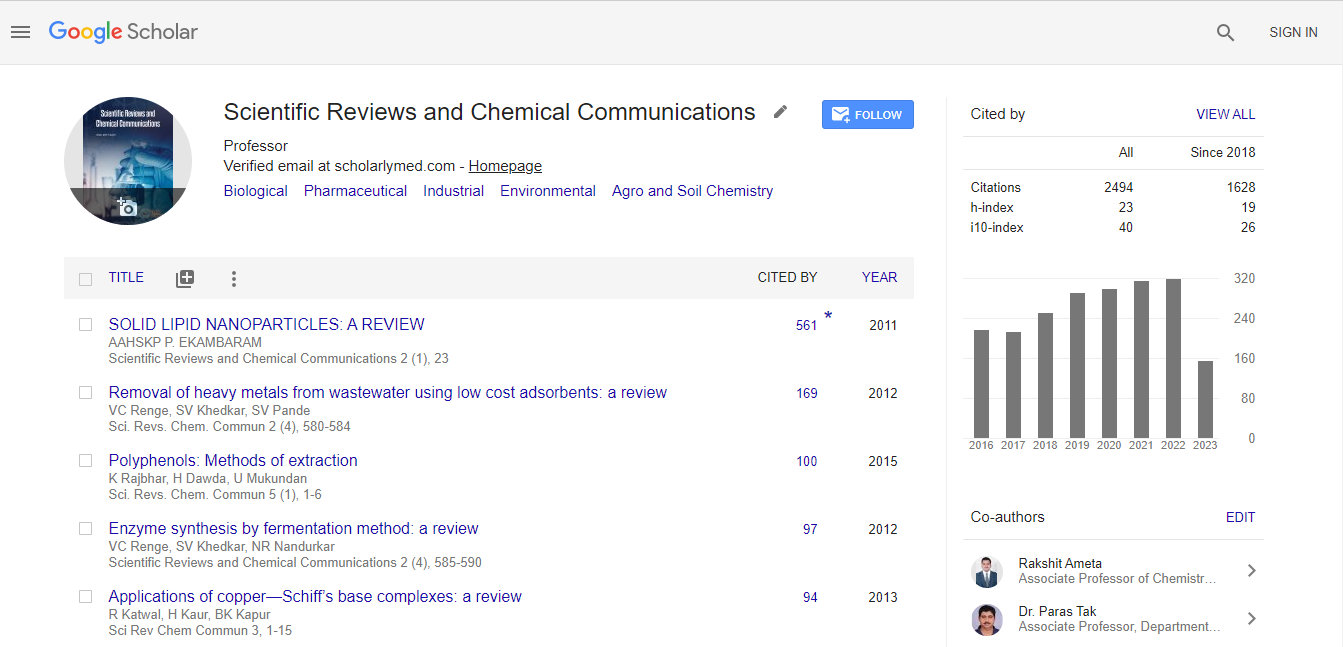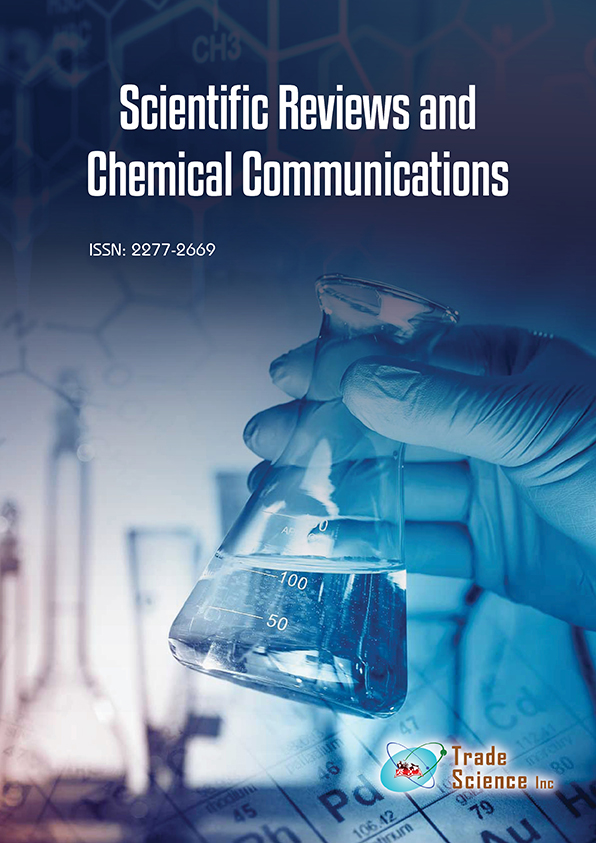Review
, Volume: 12( 3)Mutual solubilities of ethylene glycol and organic diluents investigated using gas chromatography and NMR
- *Correspondence:
- Irina S. Joseph Associate Professor, Ullswater Avenue, West End Southampton, Hampshire UK, E-mail: chemcommun@scholarlymed.com
Received date: 07-July-2023, Manuscript No. tssrcc-23-108898; Editor assigned: 10-July-2023, PreQC No. tssrcc-23-108898(PQ); Reviewed: 12-July-2023, QC No. tssrcc-23-108898(Q); Revised: 17-July-2023, Manuscript No. tssrcc-23-108898(R); Published: 27-July-2023, DOI. 10.37532/2277-2669.2023.11(3).8-11
Citation:Irina S. Joseph. Mutual Solubilities of Ethylene Glycol and Organic Diluents Investigated using Gas Chromatography and NMR.2023;11(3):8-11 .
Abstract
The solubility of Ethylene Glycol (EG) in various organic diluents is of utmost importance in a wide range of industrial applications, spanning from chemical synthesis to pharmaceutical formulations. To better understand these solubility behaviors, two powerful analytical techniques, Gas Chromatography (GC), and Nuclear Magnetic Resonance (NMR), are commonly utilized. This review article aims to present a comprehensive overview of recent advancements in the field, particularly in the mutual solubilities of ethylene glycol with organic diluents, with a specific focus on the insights obtained through GC and NMR methodologies. The article delves into an in-depth examination of experimental techniques employed to study the solubility behavior of these systems. It explores the nuances of using GC and NMR in this context, highlighting their significance in providing valuable data and aiding researchers in drawing meaningful conclusions. Furthermore, the review article also discusses thermodynamic modeling approaches used to understand the underlying principles governing the solubility interactions between ethylene glycol and organic diluents. By analyzing these models, researchers can gain a deeper understanding of the factors influencing solubility, leading to a more comprehensive comprehension of the overall system behavior. The practical implications of these findings are explored across diverse industrial sectors, emphasizing the impact of mutual solubilities on various processes. Whether it be in chemical manufacturing or pharmaceutical industries, a profound understanding of the mutual solubility behavior is crucial in optimizing processes, designing efficient formulations, and enhancing product quality. Conclusion, this review article aims to synthesize recent research on the mutual solubilities of ethylene glycol with organic diluents, highlighting the significance of GC and NMR techniques. Through a combination of experimental studies, thermodynamic modeling, and industrial applications, the article provides valuable insights that contribute to advancements in multiple sectors and pave the way for further research in this field.
Keywords
Phase equilibria; Solubility; Ethylene glycol; Organic diluents
Introduction
The opening section of the review article establishes the context and significance of comprehending the mutual solubilities between ethylene glycol and organic diluents. It underlines the critical role this understanding plays in various industrial processes and applications, including chemical synthesis and pharmaceutical formulations. Moreover, the introduction emphasizes the importance of this knowledge in enhancing efficiency and optimizing outcomes in these fields. By gaining insights into the solubility behavior of ethylene glycol and organic diluents, researchers and practitioners can develop better formulations, improve chemical reactions, and advance various industrial processes [1]. In addition to highlighting the relevance of this research, the introduction provides a brief but informative overview of the primary analytical techniques used to investigate these solubility interactions: Gas Chromatography (GC) and Nuclear Magnetic Resonance (NMR). These techniques are essential tools in studying mutual solubilities, as they offer precise and detailed information about the components' interactions at a molecular level. Gas chromatography facilitates the separation and identification of compounds, while nuclear magnetic resonance provides valuable insights into molecular structures and interactions [2].
By presenting the importance of understanding ethylene glycol and organic diluent solubilities and outlining the analytical methods employed, the introduction effectively sets the stage for the comprehensive review that follows. It creates a foundation for readers to grasp the significance of the subsequent research and the potential applications and benefits of this knowledge in various industries.
Literature Review
Experimental techniques
This section delves into the details of the experimental methods used to study mutual solubilities. Gas chromatography, it discusses the various setups employed, including packed column GC and capillary GC, and how the sample components are separated and quantified [3]. It also covers the sample preparation process, ensuring the accuracy and reproducibility of the data. Potential sources of error in gas chromatography studies, such as column bleed and adsorption, are addressed.
Concerning nuclear magnetic resonance, this section outlines the principles behind the technique and the different NMR experiments used to investigate mutual solubilities. It explains how chemical shift titration experiments can be used to measure solubility parameters and interactions between the solute and solvent molecules. Additionally, it covers diffusion NMR and relaxation measurements, which provide insights into molecular mobility and interactions.
Gas chromatography studies
This section focuses on the recent advancements in gas chromatography-based investigations of the mutual solubilities between ethylene glycol and organic diluents. Studies examining the influence of variables such as temperature, pressure, and diluent composition on solubility behavior are discussed [4]. The advantages of using gas chromatography, including its sensitivity and ability to analyze complex mixtures, are highlighted. Additionally, the limitations, such as column overloading and discrimination effects, are also addressed.
Nuclear magnetic resonance studies
The NMR studies section provides an overview of how nuclear magnetic resonance is utilized to study mutual solu bilities. It discusses different NMR techniques, such as chemical shift titration, diffusion NMR, and relaxation measurements [2]. Chemical shift titration experiments are explained in detail, including how they can be used to determine the concentration of each component in the mixture and quantify solubility parameters [1]. The unique insights provided by diffusion NMR, which can be used to study molecular mobility and diffusion coefficients, are also discussed.
Thermodynamic modeling
This section explores the importance of thermodynamic modeling in understanding the mutual solubilities of ethylene glycol and organic diluents. Various thermodynamic models, including the Nationally Recognized Testing Laboratory (NRTL), UNIQUAC, and Wilson models, are explained, along with their applications in predicting phase behavior and solubility data. The accuracy and limitations of these models are addressed, and the importance of combining experimental data with thermodynamic models to obtain accurate predictions is emphasized [5].
Practical applications
In this section, the review article highlights the practical implications of mutual solubility data obtained through GC and NMR studies. It provides examples of how this knowledge is applied in different industries, such as selecting appropriate solvents for chemical reactions and formulating pharmaceutical products. The review examines case studies from real-world applications to illustrate the significance of understanding mutual solubilities in various industrial sectors.
Challenges and future perspectives
This section addresses the challenges faced in studying mutual solubilities using GC and NMR techniques. Some challenges may include the complexity of the mixtures and potential limitations of the experimental methods. The review also explores potential future research directions and emerging techniques that could enhance our understanding of these systems. This could include advancements in NMR technology, improvements in thermodynamic modeling, or the development of new analytical techniques.
Conclusion
The conclusion summarizes the key findings from gas chromatography and NMR studies of mutual solubilities between ethylene glycol and organic diluents. It reiterates the significance of this knowledge in various industrial applications and emphasizes the need for continued research in this field. The conclusion may also discuss how the integration of gas chromatography and NMR data, along with thermodynamic modeling, can lead to more robust predictions and applications in the industry.
References
- Janssen CH, Macías-Ruvalcaba NA, Aguilar-Martínez M, et al. Metal extraction to ionic liquids: the relationship between structure, mechanism and application. Int Rev Phys Chem. 2015;34(4):591-22.
- Okamura H, Aoyagi N, Shimojo K, et al. Role of Tf 2 N− anions in the ionic liquid–water distribution of europium (iii) chelates. RSC advances. 2017;7(13):7610-8.
- Turanov AN, Karandashev VK, Baulin DV, et al. Solvent extraction of lanthanides (III) with mixtures of 1, 3, 5-tris (2-diphenylphosphoryl-4-ethylphenoxymethyl) benzene and 4-benzoyl-5-methyl-2-phenyl-3-pyrazolone. Russ Chem Bull. 2021;70(12):2416-21.
- Tang Y, Li M, Lin Y, et al. A novel green diluent for the preparation of poly (4-methyl-1-pentene) membranes via a thermally-induced phase separation method. Membranes. 2021;13;11(8):622.
- Atanassova M. Solvent extraction chemistry in ionic liquids: An overview of f-ions. J Mol Liq. 2021;1;343

